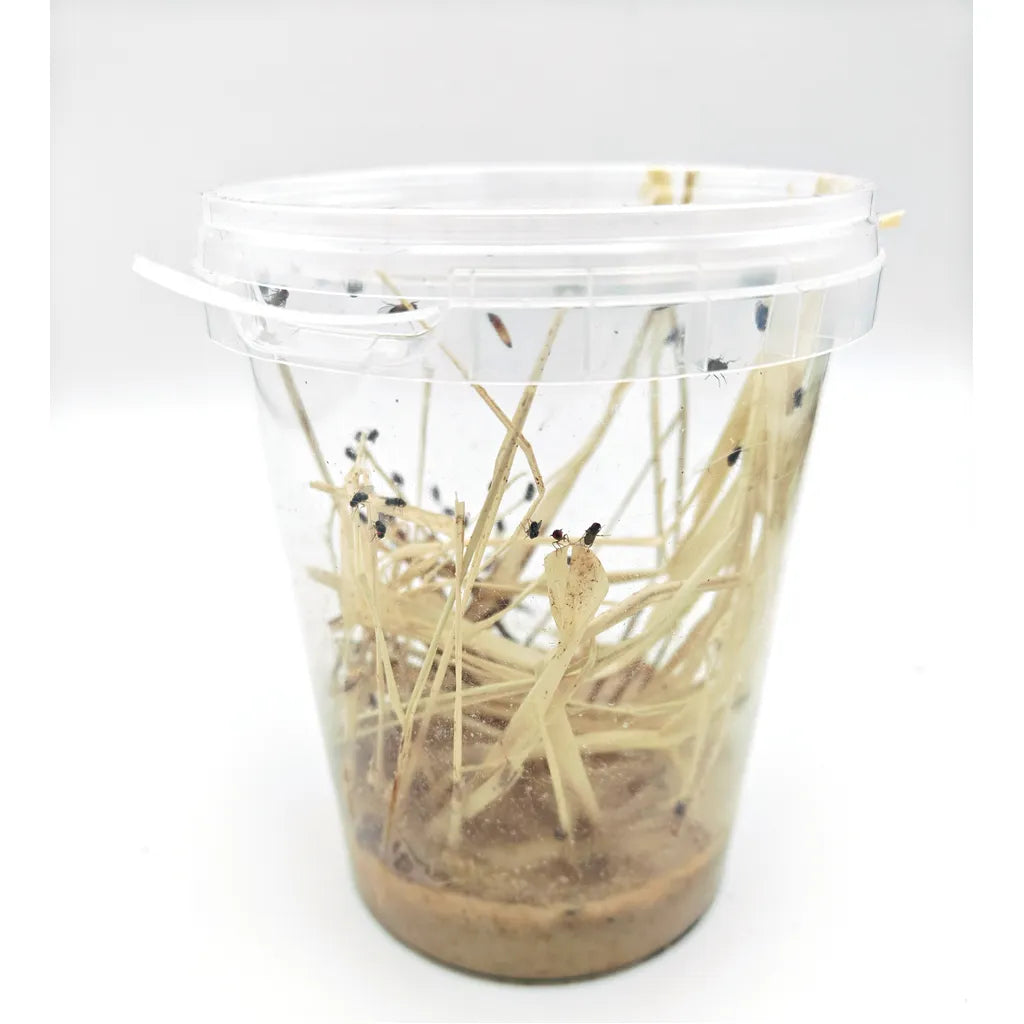Tutorial: How and when to feed your praying mantises

(For the purposes of this tutorial, I will use photos of a young male Rhombodera latipronum from my breeding. A magnificent species with the particularity of having a shield on its back.)
Why is it important to feed in good quantities? Mantises, especially females, are super predators. They will catch prey until their abdomen is cut open or they develop an abdominal hernia that can be fatal (their organs come out through the space between the abdominal segments). Although strictly carnivorous, mantises can eat just about anything, from arthropods to invertebrates, bees, flies, cockroaches and other "pests", caterpillars, dragonflies, spiders and even some lizards. However, when breeding, grasshoppers and crickets should be avoided. Grasshoppers because they are powerful insects that can injure your mantis and crickets... well, we don't know exactly, there would be an infestation in cricket farms that would make the mantises sick. It's not very clear but it's true: Crickets make praying mantises sick.
If in nature they cannot capture insects at will in breeding, it is up to you to play the role of regulator.
Abdominal Observation: The Key to Knowing if Your Mantis Is Hungry
The best way to determine if your praying mantis needs food is to observe the size of its abdomen. Here are three typical conditions that you can identify from the attached photos:
-
Thin, flat, and often upwardly curved abdomen
- Meaning : Your mantis is hungry.
- Action : Offer it prey appropriate for its size (crickets, flies, small insects). Make sure the prey is live, as mantises hunt moving prey.

-
Slightly rounded abdomen
- Meaning : Your mantis is fed properly but might still accept small live prey if active.
- Action : No immediate need to feed, but you can observe its behavior. If it appears to be hunting, offer it a small prey item. A fly, for example, is not very nutritious but very stimulating.

-
Very swollen abdomen + visible blood-red inter-abdominal segment space.
- Meaning : Your praying mantis has eaten too much
- Action : Wait a few days before feeding it again. An overfed praying mantis may have difficulty climbing or moving, and at worst, may rupture its abdomen. Give it time to digest.
- Don't worry too much if this happens; the risk of an incident is low. Just wait for it to "deflate." It will probably be lethargic for a few days; this is normal as it digests. In nature, praying mantises rarely feed, but in large quantities; they are used to going from starving to "full."

Feeding frequency
- Young mantises (L1 to L3) : Feed daily or every 2 days with small, suitable prey (fruit flies, small aphids). Be very generous but avoid leaving prey lying around if the mantis does not eat it, as it could become stressed.
- Subadult and adult mantises : Feed every 2 to 3 days. Match the prey size to the size of your mantis. Adult females may consume slightly larger prey.
Tips for optimal feeding
- Always offer live insects that are appropriate for the size of your praying mantis: overly large prey could stress or injure your insect. A good indicator is to offer prey that is the size of your praying mantis's "captive" forelegs.
- Observe its behavior. A mantis that is actively hunting or appears to be exploring its habitat is usually ready to eat.
- Avoid feeding immediately after a molt. Wait at least 24 hours for its exoskeleton to harden.
Why abdominal observation is essential
The condition of the abdomen not only helps regulate food intake but also prevents overfeeding, which could lead to mobility problems or a reduced life expectancy.
Side note: Mantises have a strictly carnivorous diet, and only eat live insects. Don't give them honey, it's a myth, they don't eat it in the wild, don't start in captivity. You don't give a snake honey? Well there you go. A type of carnivorous insect remains a carnivore from its larva to its adult stage.
If you ever feel like feeding your praying mantis even though it doesn't need it, you can give it flies, fruit flies, or butterflies. Generally speaking, flying insects aren't very nutritious. These three types of insects have practically no calorific value for a carnivore. In moderation, though.
That's all from me! I wish you good luck and success in breeding this formidable predator.
If you have any questions, please send us a message on social media. ;)



1 comment
Susan Rybicki
Bonjour. Merci beaucoup pour ce tutoriel! J’ai récupéré du froid une mante religieuse verte à 900m. Je lui ai fait un biotope je pense convenable. Mais trouver des insectes volants en hiver? J’ai trouvé sous les souches des scolopendres. Elle aime bien les petites mais a peur des grandes. Je lui donn des grillons que j’ai trouvé dans une animalerie. Mais j’aimerais bien diversifier.
Elle a pondu hier une petite meringue sur une branche.
J’ai besoin de conseils pour la nourriture.
Merci mille fois Susan
Leave a comment
This site is protected by hCaptcha and the hCaptcha Privacy Policy and Terms of Service apply.